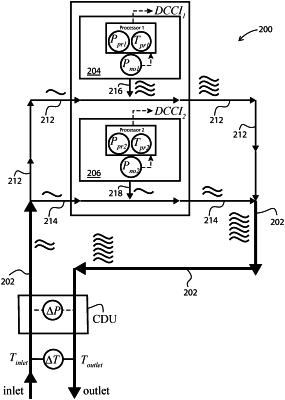| CPC H05K 7/20281 (2013.01) [G06F 11/3062 (2013.01); H05K 7/20836 (2013.01)] | 18 Claims |

|
1. A method comprising:
heating a flow of liquid by transfer of heat with a first computing device and a second computing device, wherein the flow of liquid traverses from an inlet upstream from the first and second computing devices to an outlet downstream from the first and second computing devices;
determining a first dynamic cooling capacity index for the first computing device;
determining a second dynamic cooling capacity index for the second computing device; and
allocating processing workload among the first computing device and the second computing device based on the first dynamic cooling capacity index and the second dynamic cooling capacity index, wherein allocating processing workload among the first computing device and the second computing device comprises allocating workload to maintain at least a minimum temperature difference between a temperature of the flow of liquid at the inlet and a temperature of the flow of liquid at the outlet.
|